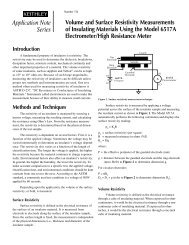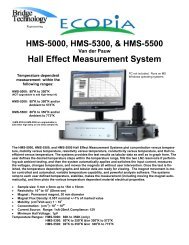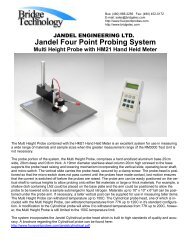Probe Head Application Notes - Four Point Probes
Probe Head Application Notes - Four Point Probes
Probe Head Application Notes - Four Point Probes
- No tags were found...
You also want an ePaper? Increase the reach of your titles
YUMPU automatically turns print PDFs into web optimized ePapers that Google loves.
Tele: (480) 988-2256Fax: (480) 452-0172Email: sales@bridgetec.comWeb: http://www.bridgetec.com/<strong>Application</strong> <strong>Notes</strong> Regarding Jandel <strong>Four</strong> <strong>Point</strong> <strong>Probe</strong> <strong>Head</strong>sThe work involved in building a Jandel four-point probe head is similar insome ways to horology (watch making) in that it is laborious, meticulous,and time consuming. The founder of Jandel Engineering is, among otherthings, a trained horologist. Jandel's probe production department consistsof 6 individuals, with final assembly conducted by four senior employees,three of whom boast more than 15 years experience. The process involvesgrinding and polishing of the probe needles to a specific radii, precision machiningof various parts, the installation of tiny jeweled bearings as probeguides, and meticulous assembly. Final testing involves the use of calibratedmeasurement instruments including an optical interferometer, avideo inspection system, and an electronic force gauge. All Jandel probeheads meet stringent accuracy requirements for tip radii, tip spacing, tipplanarity, and spring loads.Jandel Cylindrical <strong>Probe</strong>General SpecificationsJandel <strong>Probe</strong>s are made almost entirely of non-magnetic materials exceptfor the piano wire springs. Most of the probes have an aluminum body,nosepiece, and upper guide. The tips are tungsten carbide and includejewel bearings, i.e. upper and lower synthetic ruby needle guides. Thereare a few tiny stainless steel screws used. The standard temperature limitfor the Cylindrical probe is +120 o C. Jandel offers a high-low temperatureversion of the Cylindrical probe which has a jeweled nosepiece pad inplace of the standard acrylic pad. This version can withstand temperaturesfrom LN2 temperature (77K) up to +200 o CAccuracyJandel <strong>Probe</strong>s are built to a high level of mechanical accuracy. Tip spacings are within a 10 micron toleranceand spring loads are set to within +/- 5 grams. Tip radii tolerance is quoted at 10%, however, the most commonradii such as 40 and 100 micron are typically within 5%.SpacingJandel offers probes with close needle spacing (0.5 mm) in several models including the Cylindrical <strong>Probe</strong>,Six-Way <strong>Probe</strong>, <strong>Four</strong>-Pin <strong>Probe</strong>, and Cartridge with Lead. <strong>Probe</strong>s built with 0.5mm tip spacing are availablewith spring loads of up to 100 grams only. Tip spacings are available up to 1.591mm. Tip spacing is measuredfrom the center of the contact area. To measure the tip spacing, the needles are pressed onto a sapphireflat and then interference rings are viewed using an optical interferometer. A micron graduated micrometeris used to ensure the distance between the centers of the rings.Spring LoadsJandel uses a custom-made electronic force gauge to set and check theloads for each needle individually. The Cylindrical probe has a user adjustablepressure which can be adjusted within one of three ranges asfollow: 10 to 30 grams, 30 to 60 grams, or 60 to 150 grams of pressureper tip. Spring loads above 150 are available, up to 200 grams, but arefixed without adjustment. The pressure adjustment knob on the top ofthe Cylindrical probe is made of PTFE (Teflon). Turning the spring loadadjustment knob clockwise increases the load. The stated spring load isachieved at the point where the probe head has been lowered until theacrylic nosepiece pad has touched the material being tested.
Spring Loads (continued)The Cylindrical and similar model Jandel probes can be built with 250 gram loads on probes that have tipspacing of 1mm or greater, however, Jandel warns of accelerated tip wear.Tip MaterialJandel Engineering offers two probe tip materials, i.e., tungsten carbide and 50% osmium alloy. Osmium alloytips are somewhat softer and less durable, and only in a few instances do they provide sufficiently superiorcontact to justify their usage. Here are some comments from the founder of Jandel Engineering Ltd, JohnClark, regarding the usage of osmium alloy tips compared with the much more common and more durabletungsten carbide tips: "The limit of our knowledge of osmium as an ELEMENT is that it is the most dense, andthat it cannot be fabricated. The material we use for probe tips is used for 'pen-balls' - those used on gold pennibs to give a long writing life. The ones we use are a mixture of platinum group metals including osmium,platinum, rhodium, palladium etc. The specification we had merely stated "not less than 50% osmium alloy".We have had this checked by a laboratory and it was true at that time, some years ago, and this was for aproprietary alloy "Irit 57" made by the Degussa company. From our point of view "osmium" (alloy) tips are alot softer than TC and inclined to crumble when we shape them. For this reason we are cautious when weaccept requests for less than 100 microns x 100g, and really don't like the idea of making 40 microns. I amfairly sure it is more conductive, and may possibly offer less contact resistance in some circumstances. Ouroutput of osmium tipped probes is less than 2% of the total we make and I guess this is on account of theirfailure to maintain a tip profile for very long. Going back to the early days of 4-point probing, people used tomake their own probe heads with 'gramophone needles' (not fibre!). Such needles were often osmium alloytipped, so are the needle points used in moving iron and moving coil meters. I think the use of osmium alloyhere was more against corrosion than anything else. Cynically it is my belief that the use of osmium alloy tipsoriginated from these early attempts and has persisted to the present day."Tip RadiiRadii of 100 microns or less are applied as a whole radius and larger radii are applied to a 150 micron flat. Insome instances 500 micron radii can be applied to the whole of the tip, although the needle is only 400 micronsdiameter so this is not quite a 'full' radius. The needle material is tungsten carbide and therefore veryhard, however repeated use will eventually produce 'flats' on the end of the radii. This will not necessarily preventthe probe from working, and erroneous results are the best guide to when a probe head is no longerworking at an optimum level. Jandel has never been able to find a probe tip supplier that can provide tips thatmeet their requirement for radius accuracy. Jandel hand-grinds all of their tips on a precision watchmaker’slathe, and then makes fine adjustments to the tip shapes using diamond files and diamond paste.
PlanarityDuring manufacture, the needles are observed by the maker to visually check planarity using a reflective surface.To the trained eye it is very obvious if the needles progressively rise or fall in relation to the pad. Duringfinal inspection a force gauge is set to make an audible tone when the sensor contacts the needle. The testerchecks the value on the micrometer gauge for each of the needle contact points and in this way the planaritycan be evaluated.Retraction<strong>Probe</strong> tip retraction distance for the Cylindrical probe is set to 0.5mm. The distance is measured as the distancefrom full tip extension to the point at which the tip is retracted until the acrylic nosepiece pad touchesthe material being measured.CableThe standard cable used on Jandel probes is a 0.1mm multi-core for the internal laid up wires. The internalwires are coated in PTFE, and the outer jacket is also PTFE coated. Insulation is at a minimum of least 10 13ohms between wires at 500 volts.Linear or Square Tip ArrayThe standard probe tip array is linear, however, a square array version of the Cylindrical probe is available.The Six-Way <strong>Probe</strong>, <strong>Four</strong>-Pin <strong>Probe</strong>, and Cartridge with Lead are also available in the square array. Thechoice of square tip array does not affect the price. The square array four-point probe has a smaller footprintwhich allows smaller samples to be measured, and when probing onto wafers it allows the user to measurecloser to the edge of a sample before a correction factor is required. The voltage signal for a square arrayprobe is one half of the voltage signal measured when using a linear array probe. The smaller voltage signalmust be taken into account when using four point probing electronics and software that are designed to calculatesheet resistance based upon the assumption that a linear array probe is being used. Square array probesare available with tip spacing as close as 0.635, but not 0.5mm.Jandel Engineering Limited has been manufacturing high quality four point probe heads since 1967.Jandel four point probe heads are of the highest quality commercially available anywhere in the world.For further information, contact:Bridge TechnologyPO Box 9275Chandler Heights, AZ 85227Tel: 480-988-2256Cell: 480-242-6703Fax: 480-452-0172Email: sales@bridgetec.comWeb: www.fourpointprobes.comIn 2007 Jandel Engineeringcelebrated 40 years in businessOne of two video inspection systems that Jandel uses
















